All 6 entries tagged Egypt
View all 8 entries tagged Egypt on Warwick Blogs | View entries tagged Egypt at Technorati | There are no images tagged Egypt on this blog
September 01, 2020
The lead tokens of Roman Egypt: Thoughts on function
Based upon the work of J. G. Milne, lead tokens in Roman Egypt are thought to be an unofficial coinage. Milne came to this conclusion because, when he analysed the Roman coins from Oxyrhynchus’ rubbish dumps, he noticed that there were fewer bronze coins present for the period AD 180 – 260 (Milne 1908; Milne 1922). He thought that the lead tokens replaced the lower denomination bronze. The Oxyrhynchite tokens depicting Athena are not, however, standardised as would be expected for even a pseudo-coinage. It is also apparent that lead tokens were in use in Roman Egypt before the period AD 180 – 260, as evidenced by an example bearing the image and name of Messalina, and a series of tokens found at Abydos dating to the first century BC. Despite his awareness of these examples, Milne still took a broad-brush approach to his interpretation that tokens were low denomination coins. It is therefore worth exploring other possibilities for the ways in which tokens could have functioned in the province.
Milne’s theory regarding the use of tokens as a low denominational coinage is not totally unfounded, as there are a small quantity of tokens that indicate a denomination. These include those with the legend ‘OBOΛOI B’ (‘two obols’, see figure 2) from Tebtunis and the Serapeum at Saqqara, as well as a specimen in the Ashmolean collection with the legend ‘ΔIOB’ (‘diob[ol]’, see figure 1. It is also possible that the I is instead a Φ that has become worn. If this is the case, then the inscription cannot refer to a diobol). These are, however, in the minority in comparison to hundreds of other specimens that do not bear a denominational mark, which suggests that this was not an extensive issue of tokens. The thin flans of the examples from Tebtunis also suggest that they were impractical for everyday use, and so may not have been intended for quotidian circulation.
  |
Figure 1: Token possibly naming the denomination diobol. Obverse: Wreath, within which ΔIOB(?); solid line border. Reverse: Egyptian style altar(?); solid line border. Metal: Lead. Diameter: 26mm. Weight: 7.12g. Die axis: 12. Ashmolean Museum, Milne 5441. Image: Ashmolean Museum.
The paucity of tokens bearing a denomination, alongside the impracticality of the Tebtunis issues, suggests that another possibility is worth exploring. It is feasible that these tokens were intended to represent the given amount, without actually holding this worth or circulating as a coin. A lead token series from Rome refers to 1000 sestertii, but it seems unlikely it would have been worth that amount (TURS 1460). A modern parallel is the ‘Hell money’ used today in Asia, which while having the appearance of a banknote, exhibit denominations running into the millions. It is offered to the ancestors and not accepted as legal tender (Scott 2007, 26-28). Although these examples have a much higher denominations than on those found on the tokens from Roman Egypt, they demonstrate that a denomination does not necessarily indicate an all-purpose coin. This point is particularly pertinent as a token of the ‘OBOΛOI B’ type was found at the Serapeum of Saqqara at Memphis. When this token, and others bearing the ethnic ‘MEMΦΙC’ (Memphis), were studied by Longperier in the nineteenth century he posited that they could be religious coins used exclusively at Memphis (Longperier 1861, 411). He states that Pausanias references the use of a ‘local coin’ as a votive offering at Memphis (Pausanias Description of Greece 7.22, 3-4; Longperier 1861, 412). Pausanius implies that the coins were copper, which does obviously not fit the description of the lead tokens. The nome coinage of Roman Egypt displays imagery relevant to each of the nome districts and could perhaps fit this description, however, this was struck at Alexandria and so was ‘local’ to a questionable extent. The fact that ‘local coins’ were important for votive offering at Memphis does, however, leave open the possibility that the lead tokens fulfilled this need. A ‘coin’ created specifically as a votive offering can feasibly be encompassed within the term ‘token’.
 |
Figure 2: : Token from Tebtunis. Obverse: Apis bull facing right, with solar disc between horns, to left Isis(?) standing right wearing solar disc and to right janiform figure(?) standing left and holding uraeus serpent. Crescent and garland above in field; border of dots. Reverse: Nilus sitting left, holding cornucopia in left hand and reeds in right, Alexandria-Euthenia standing before him holding ear of corn aloft in right hand; border of dots; OBOΛOI B. Metal: Lead. Diameter: 30mm. Die axis: 12. Image: Milne 1900, pl XXVI, fig 1.
Others have posited that some of the lead tokens were tax receipts (Rostovtzeff and Prou 1900, 151-152; Mitchiner 1984). Some tokens bear the legend ΕΠ ΑΓΑΘW, which has been translated to mean ‘interest payable upon wealth’ (Mitchiner 1984, 113). However, tax receipts are known from papyrological evidence in Roman Egypt, so it seems unlikely they would take the form of tokens as well. There are also many instances in the ancient world where the phrase means ‘good fortune’, such as this inscription on a marble column drum from Lepcis Magna. The phrase is also found on rings in the Roman period (Le Blant 1896, 90; Ogden 1990, 109). Given that tokens in the ancient world are likely to have been used for euergetic distributions, this phrase would not be out of place on such tokens.
A group of tokens that are unprovenanced within Egypt can also offer an alternative function. They depict Athena on one side (unconnected to the Athena tokens from Oxyrhynchus) and have the legend ΑΓΟ (‘AGO…’, see figure 3) on the other face. It is likely that the legend refers to the agoranomoi, who oversaw markets in the Greek world. Tokens with similar legends – ΑΓ (AG…), ΑΓΟΡ (AGOR…) and ΑΓΟΡΟΝΟΜΩΝ (AGORANOMON) - have also been discovered in the Athenian agora. A possibility for their use that they were issued as proof of payment to sacrificial banquets organised by the agoranomoi (Bubelis 2013, 125). This is also plausible for Roman Egypt, as a papyrus from Karanis dating to the early third century AD also provides a link between religious banquets and their organisation by the agoranomoi (P.Mich. 8511).
 |
Figure 3: Token possibly referring to the agoranomoi. Obverse: Athena standing left, wearing Corinthian helmet, left hand resting on shield at feet to right, outstretched left hand holding Nike with wreath and palm; solid line border. Reverse: AΓO; solid line border. Metal: Lead. Diameter: 24mm. Weight: 9.98g. Die axis: 12. Köln, Institut für Altertumskunde accession no. AL_3560. Image: Köln, Institut für Altertumskunde.
The instances highlighted above are only a minority of the tokens found in Roman Egypt, however, they provide alternative suggestions for utilisation other than a low denomination coinage, and emphasise how tokens could have a variety of functions within the province.
This blog is written by Denise Wilding. The content of this blog is adapted from: Wilding, D. 2020. Tokens and Communities in the Roman Provinces: An Exploration of Egypt, Gaul and Britain. Unpublished PhD thesis, The University of Warwick.
With thanks to the Humanities Research Fund, University of Warwick for their support.
Bibliography
Blant, E. Le. 1986. 750 Inscriptions de pierres gravées inédites ou peu connues. Paris: Imprimerie Nationale.
Bubelis, W. 2013. “The Agorastikon of Hellenistic Athens: Not a Market-Tax.” Zeitschrift für papyrologie und epigraphik 185: 122–26.
Longperier, A. 1861. “Monnaies du Sérapéum de Memphis. Trouvaille de Myt-Rahinch.” Revue Numismatique VI: 1–24.
Milne, J. G. 1908. “The Leaden Token Coinage of Egypt under the Romans.” The Numismatic Chronicle and Journal of the Royal Numismatic Society 8: 287–310.
Milne, J. G. 1922. “The Coins from Oxyrhynchus.” The Journal of Egyptian Archaeology 8: 158–63.
Mitchiner, M. 1984. “Imperial Portrait Tesserae from the City of Rome and Imperial Tax Tokens from the Province of Egypt.” The Numismatic Chronicle 144: 95–114.
Ogden, J. M. 1990. “Gold Jewellery in Ptolemaic, Roman and Byzantine Egypt.” Unpublished PhD thesis, University of Durham. http://etheses.dur.ac.uk/1457/.
Pausanias, Description of Greece, trans. W. H. S. Jones. 1918. London: Heinemann.
Rostovtzeff, M., and M. Prou. 1900. Catalogue Des Plombs de l’antiquité, Du Moyen Age et Des Temps Modernes Conservés Au Département Des Médailles et Antiques de La Bibliothèque Nationale. Paris: Rollin et Feuardent.
Scott, J. L. 2007. For Gods, Ghosts and Ancestors: The Chinese Tradition of Paper Offerings. Hong Kong: Hong Kong University Press.
August 17, 2020
Lead Tokens depicting Athena from Roman Oxyrhynchus
The result of our excavations showed that I had been so far right in that the rubbish mounds were nothing but rubbish mounds; and the miscellaneous small anticas which we found are of little interest…
Grenfell 1896-1897, 3.
Oxyrhynchus, the ‘city of the sharp-nosed fish’, is situated in the Fayum of Egypt. Originally an Egyptian city that was colonised by the Greeks, it continued to thrive under the Romans. Today is best known for the reams of Ptolemaic and Roman papyri discovered in its rubbish heaps by Grenfell and Hunt in the late nineteenth and early twentieth centuries. There is, however, more to Oxyrhynchus than its papyri, and after more than a hundred years some of the so-called ‘miscellaneous small anticas’ deserve reassessment.
Amongst the artefacts of which Grenfell was so disparaging, are around three hundred lead tokens, dating to the Roman period (Milne 1922, 159). These small, unassuming objects, often worn and with traces of their designs barely discernible, are largely ignored in modern scholarship. A series of papers published in the early 20th century by J. G. Milne focused on identifying the types, and posited that they functioned as a low-denomination token coinage. How tokens were used in Roman Egypt still remains uncertain, but analysis of their iconography can move beyond identification of types.
Milne rightly noted that different series of tokens were present at Oxyrhynchus (Milne 1908, 297). Some have imagery similar to the Alexandrian coinage, depicting for instance deities such as Serapis or Nilus. Like Alexandrian coins, tokens often have a date in regnal years which is signified by an ‘L’ before the numerals in Greek. Unlike coins, tokens in Roman Egypt don’t bear the portrait of the emperor, and so it is usually unclear to whose reign this date refers. Tokens of this series are found on other sites in Egypt, such as Antinoopolis, Karanis and elsewhere in the Fayum, as well as just outside of Egypt at Qasr Ibrim and in a shipwreck off Israel’s Carmel coast.
In contrast, another series of tokens appears to have local significance to Oxyrhynchus. These all feature the goddess Athena on one face. Most frequently it is her bust that is depicted (Figure 1) but she also appears fighting a serpent (Figure 2), and sometimes her cult statue features within a temple. Most tokens pair her with Nike on the reverse, aside from a small subset on which Zeus is depicted seated (Figure 2).
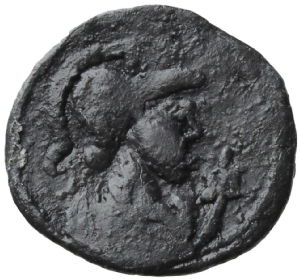 |
 |
Figure 1: Token depicting Athena with labrys. Obverse: Bust of Athena-Thoeris right, wearing Corinthian helmet, labrys to front. Solid line border. Reverse: Nike advancing left, holding wreath in right hand and palm in left hand; ΟΞ. Solid line border. Metal: Lead. Diameter: 20mm. Weight: 3.34g. Die axis: 11. Ashmolean Museum, Milne 5302. Image: Ashmolean Museum.
Despite the variation in the manner of her depiction, there is clearly a preference for tokens featuring Athena at Oxyrhynchus; Milne identified the goddess on 184 tokens out of a total of 271. This frequency is further emphasised by the fact that the Oxyrhynchite Athena types are not found anywhere else in Egypt (Milne 1908, 297. This still holds true based on the data available today, which includes discoveries made after Milne’s study.). The presence of the Greek legend ‘ΟΞ’ (OX) on some of the Athena tokens also clearly refers to the first two letters of Oxyrhynchus. This legend works alongside the imagery to emphasise the distinct local character of this type of token.
The uniqueness of these tokens to Oxyrhynchus is further exemplified by the choice of attribute for Athena on the tokens: the labrys, or double-headed axe. It is present on types where she is depicted attacking a serpent and also alongside her bust. The labrys is an unusual attribute for Athena. It does not feature alongside her on many depictions from antiquity, aside from one representation from Mycenae, the nome coinage of Οxyrhynchus, possibly on a terracotta lamp from Οxyrhynchus, and perhaps as part of a statue of Athena found at Οxyrhynchus (LIMC II, Athena no. 2; LIMC II, Athena no. 27; RPC III 6355-6358; British Museum OA.11020;Mathiopoulos 2001, 202-217 for the statue, who posists that the statue’s missing attribute is a cornucopia. However, a labrys is also a possibility, given the association of Athena with this attribute at Oxrhynchus).
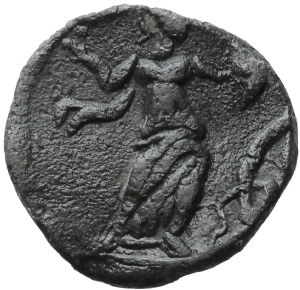 |
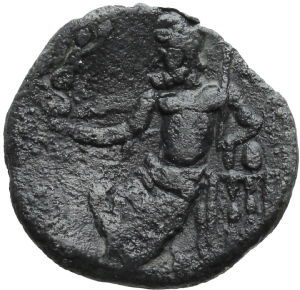 |
Figure 2: Token depicting Athena fighting serpent. Obverse: Athena-Thoeris advancing right, holding labrys in right hand and shield in left, attacking serpent before her. Reverse: Zeus seated left, in right hand holding Nike right with wreath, and in left hand holding sceptre. Metal: Lead. Diameter: 23mm. Weight: 7.88g. Die axis: 11. Ashmolean Museum, Milne 5304. Image: Ashmolean Museum.
In terms of the significance of the labrys to the town, current scholarship does not appear to have reached a definitive conclusion. In her study of the double-headed axe, Kouremenos states in reference to the nome coinage of Οxyrhynchus that it might be associated with workmen in the city that used the double axe as a woodworking tool (Kouremenos 2016, 47). Others have interpreted the presence of the labrys on the nome coinage as an ‘Egyptian’ emblem, due to the fact that in art it was often depicted with the Egyptian god Tutu, in which context it has been interpreted as an apotropaic symbol (Weber and Geissen 2013, 168). Its association with Athena at Οxyrhynchus might be viewed as acknowledging her role as a protective guardian goddess of the town, while also amalgamating Egyptian and Greek elements (Weber and Geissen 2013, 168). The labrys is, however, found frequently in Greek and Roman art (Kouremenos 2016, 43-50 for overview). In this regard, it appears in many places in different contexts, similar to the manner in which the imagery of Athena is common. It is, however, only when Athena and the labrys appear together in the specific context of the material culture of Οxyrhynchus that they are able to transform into a new image which becomes associated with the locality.
 |
Figure 3: Coin of Hadrian (nome coinage). Obverse: laureate bust of Hadrian, right; border of dots; ΑΥΤ ΚΑΙ ΤΡΑΙ ΑΔΡΙΑ CΕΒ. Reverse: Athena standing facing, head left, wearing Corinthian helmet, holding labrys in left hand and Nike in extended right hand; border of dots; ΟΞΥΡ/ LΙΑ. Metal: Bronze. Weight: 4.70g. Mint: Alexandria. Date: AD 117-138. RPC III 6357. Ashmolean Museum Accession no. HCR34309. Image: Ashmolean Museum.
The unusual pairing of Athena with the labrys at Οxyrhynchus was not her sole distinction from the ubiquitous Athena of the classical world. From numerous references in the town’s papyri, it is evident that Athena was equated with, or given the epithet of, the goddess Thoeris. There are references to ‘worshippers of the cult of Athena-Thoeris’, the ‘temple of Athena-Thoeris’ and the ‘place of the temple of Athena-Thoeris’, amongst others (P.Oxy. 3.579; P.Rein. 2.93; P.Oxy. 34.2722; P.Oxy. 50.3567). To some extent perhaps the goddesses were perceived as separate: one document refers to ‘the temple of Athena and Thoeris’ (P.Oxy. 10.1268).
Thoeris is the Greek name for the Egyptian goddess Taweret. She took the form of a hippopotamus, and her worship had become prominent at Οxyrhynchus from the late Ptolemaic period (Whitehorne 1995, 3080-82). The reason for the connection of Athena to Thoeris/Taweret in not clear, but it is perhaps because each goddess was associated with childbirth and fertility (Whitehorne 1995, 3080-82). In ancient Egypt Taweret was associated with the protection of women and children. Inscribed magical knives from the Middle Kingdom period bear apotropaic figures and texts indicating that they were for the protection of women and children, and most frequently feature Taweret as the apotropaic figure (Weingarten 1991, 4: 45 out of the 58 published knives feature Taweret). From the New Kingdom, jugs in the form of Taweret were used for the pouring of libations from a hole in one of the jug’s breasts, indicating an association with childbirth and breastfeeding mothers (Bruyère 1939, 104-107). Athena’s link to women and motherhood is less explicit, but it is perhaps her capacity as a protector that syncretises her with Taweret.
 |
Figure 4: A faience amulet depicting the Egyptian goddess Taweret. 332-30 BC. The Metropolitan Museum of Art, accession no. 26.7.888. Creative Commons CC0 1.0 Universal Public Domain Dedication.
Despite the outwardly classical style of Athena on these tokens, these syncretisms should be taken into account. The Athena depicted on these tokens’ had associations with Thoeris, and her Egyptian counterpart Taweret, which lent a particular local context to the way in which the imagery may have been viewed and read by the community of Οxyrhynchus. Veronique Dasen has also reached similar conclusions in her analysis of a gem depicting Athena attacking a serpent with a labrys, which bears the inscription ‘Thoeris’ (Dasen 2019). She considers how the imagery of the gem could have been read on both Greek and Egyptian terms due to the iconography evoking all three goddesses.
The choice to depict Athena in classical form underlines the creation of tokens in a Graeco-Roman milieu, especially as Taweret was concurrently worshipped independently at local shrines and certain populations would have recognised her Egyptian guise. This does not, however, discount the possibility that those who used and viewed tokens interpreted the image on their own terms and read different combinations of Athena, Thoeris and Taweret.
Blog written by Denise Wilding, The University of Warwick.
The content of this blog is adapted from: Wilding, D. 2020. Tokens and Communities in the Roman Provinces: An Exploration of Egypt, Gaul and Britain. Unpublished PhD thesis, The University of Warwick. With thanks to the Humanities Research Fund, University of Warwick for their support.
Bibliography
Bruyère, B. 1939. Rapport Sur Les Fouilles de Deir-El-Médineh, 1934-35. Cairo: l’Institut Français d’Archéologie Orientale.
Dasen, V. 2019. “One God May Hide Another. Magical Gems in a Cross-Cultural Context.” In Magical Gems in Their Context, Proceedings of the International Workshop Held at the Museum of Fine Arts, Budapest 16–18 February 2012, edited by K. Endreffy, Á.M. Nagy, and J. Spier, 47–58. Rome: L’Erma Di Bretschneider.
Grenfell, B. P. 1896-1897. “Oxyrhynchus and Its Papyri.” Archaeological Report (Egypt Exploration Fund) 1896-1897: 1–12.
Kouremenos, A. 2016. “The Double Axe (Λάβρυς) in Roman Crete and beyond: The Iconography of a Multi-Faceted Symbol.” In Roman Crete: New Perspectives, edited by J. E. Francis and A. Kouremenos, 43–58. Oxford: Oxbow Books.
Mathiopoulos, E. 2001. “On the Transformation of the Athena Velletri Type in Hellenistic Alexandria.” In Athena in the Classical World, edited by S Deacy and A. Villing, 197–218. Leiden: Brill.
Milne, J. G. 1908. “The Leaden Token Coinage of Egypt under the Romans.” The Numismatic Chronicle and Journal of the Royal Numismatic Society 8: 287–310.
Milne, J. G. 1922. “The Coins from Oxyrhynchus.” The Journal of Egyptian Archaeology 8: 158–63.
Weber, M., and A. Geissen. 2013. Die Alexandrinischen Gaumünzen Der Römischen Kaiserzeit. Die Ägyptischen Gaue Und Ihre Ortsgötter Im Spiegel Der Numismatischen Quellen. Wiesbaden: Otto Harrassowitz.
Weingarten, J. 1991. The Transformation of the Egyptian Taweret into the Minoan Genius: A Study in Cultural Transmission in the Bronze Age. Partille: Aström Forlag.
Whitehorne, J. 1995. “The Pagan Cults of Roman Oxyrhynchus.” Aufsteig Und Neidergang Der Romischen Welt II (18.5): 3050–91.
December 01, 2019
The crocodile as a symbol of Egypt on a victory coin of Augustus
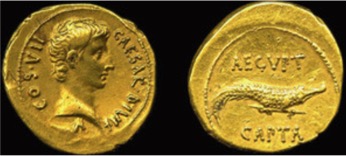 |
Gold Aureus from 27BC (RIC 12, P.86, no. 544) The obverse depicts head of Augustus with ‘CAESAR.DIVI.F.COS.VII’ inscribed. On the reverse is a crocodile facing right, representing Egypt. The reverse legend reads ‘AEGVPT CAPTA.’ Image produced courtesy of the Trustees of the British Museum.
After a tense period of civil war, Octavian’s decisive victory at the Battle of Actium in 31BC left Marc Antony with insufficient military support to win the war, and a year later Egypt was conquered and absorbed into the Roman Empire. Marc Antony and Cleopatra committed suicide, leaving Octavian as the unrivalled, sole ruler of the Roman world, a victory he was keen to advertise. The above pictured coin is a gold aureus celebrating the acquisition of Egypt. It is typical of victory coinage, with the obverse depicting a portrait bust of the ruler (who was the victor), in this case Octavian, and the reverse depicting an image symbolic of the conquered nation, in this case a crocodile. The gold aureus is similar to a near identical issue of silver denarii struck in the previous year. Both coins hailed Octavian as son of the divine Julius Caesar, establishing his legitimacy on a political and religious level.
That Octavian chose the image of a crocodile to place on the reverse of his coins is of particular interest. First and foremost, it presents Octavian as the victor over a foreign enemy. Crocodiles were popular in Roman art as images representing foreign and exotic ideals, and their use here was no doubt intended to draw attention to the war in its international context, and thus overshadow the morally dubious truth of it being, in truth, a civil war. Octavian was now the sole ruler of Rome, having violently deposed of his co-consul. It was therefore crucial for him to deter any criticism and suggestions of tyranny. The crocodile was a particularly suitable image because of its associations with danger, and thus it had the added benefit of presenting Marc Antony as a threat to Rome. This helped to authorise Octavian’s war against his fellow Roman, and once-ally, and aligns with much of Octavian’s earlier propagandist campaign against him. The crocodile therefore helps to reinforce the idea that Octavian should be hailed, not as the violent murderer of his co-consul, but as the saviour of the Roman Empire.
 |
Coin of Crassus showing a crocodile. Image produced courtesy of the Classical Numismatic Group.
This is not the first time a crocodile had been used in Roman coinage. Already in 37BC, the crocodile had appeared on the coinage of a figure largely identified as M. Licinius Crassus, son of the triumvir Crassus. It is believed that this coin celebrated Roman territory ceded to Cleopatra VII of Egypt by Marc Antony. It is interesting therefore, that this same symbol of Egypt should be used by Augustus only ten years later to celebrate the exact opposite: the conquering of Egyptian territory by Rome. On the coin of Crassus, it is likely that the crocodile was chosen because of its associations with the Nile, which itself was associated with the agricultural wealth of Egypt. We can therefore infer that this earlier use of the image of the crocodile was intended to celebrate Egypt in a gesture of diplomacy. Octavian, aware of this, may well have deliberately used this same image, already known for its associations with agricultural wealth, in order to boast of his achievement at having acquired such an important nation into the Roman Empire. Rome relied heavily on Egypt for its imports of grain, and hence Octavian’s victory was of crucial importance. It is likely the coin instilled pride in its Roman viewers, for belonging to such a large, powerful empire.
As we have seen therefore, the coin presents Octavian as a successful military leader, who not only saved, but also contributed to the Roman Empire. It also served to justify his recent war against Marc Antony by presenting it as a foreign conquest. We can see that the imagery was carefully chosen in order to secure and validate Octavian’s position as sole ruler of Rome.
 |
This month's entry was written by Richa Snell. Richa is a final year classical civilization student with an interest in material culture and iconography, which she is hoping to pursue further by studying for a master’s degree next year. She is currently writing her undergraduate dissertation on imperial uses of Egyptian imagery.
Bibliography
R.A. Gurval (1995) Actium and Augustus: The Politics and Emotions of Civil War (Ann Arbor: University of Michigan Press).
C.E. Barrett (2017) ‘Egypt in Roman Visual and Material Culture’ in Oxford Handbooks Online in Classics Studies, ed. G. Williams (Oxford; New York: Oxford University Press).
M.Swetnam-Burland (2015) Egypt in Italy: Visions of Egypt in Roman Imperial Culture (Cambridge: Cambridge University Press).
D. Vagi, Crocodiles on Roman coins familiar as the emblem of Egypt – https://www.coinworld.com/news/precious-metals/crocodiles-on-roman-coins-familiar-as-the-emblem-of-egyptian-province.html (15 Feb 2015). Accessed 31 Oct 2019.
June 01, 2017
Let's play with the portrait of Augustus! "Tesserae" and Roman Games
 |
|
Bone gaming piece showing and naming Augustus.
(From Rostovtzeff's 1904 publication of the find).
|
A variety of objects are given the Latin label “tesserae” by modern scholars: mosaic pieces, lead monetiform objects, spintriae, and small circular objects made out of bone or ivory, like the piece pictured above. On one side is a carved portrait of Augustus, while the other side gives his name in Greek (Σεβαστός) and the number one in both Latin and Greek numerals (I in Latin, A in Greek; the Greeks represented numerals through letters). Scholars originally thought that these bone objects, found all over the Roman world, served as tickets to the theatre, amphitheater or circus. But then this “tessera” and fourteen others were found in a child’s tomb in Kerch (Russia) in 1903, and our understanding of these objects changed completely.
Fifteen bone “tesserae” were found in the tomb placed in a wooden and bronze box, neatly stacked in twos. Each piece had an image engraved on one side and on the other a word accompanied by a number in both Latin and Greek. The numbers range from 1 to 15. The designs of the pieces are as follows, according to the publication of Rostovtzeff 1905 (the counters are now in the Hermitage):
- Head of Augustus / CΕΒΑCΤΟC (Augustus), I and A.
- Head of Zeus / ΖΕΥC (Zeus), II and B.
- An "athletic head" (probably Hermes) / [ΕΡΜ]ΗC (Hermes? The legend is partly obliterated), III and Γ.
- Entrance to an Egyptian building / ΕΛΕΥΣΕΙΝ(ΙΟΝ) (Eleuseinion), IIII and Δ
- Head of Herakles / ΗΡΑΚΛΗΣ (Herakles), V and E
- The word ΗΡΑΙ(Α) (Heraia) in a wreath / YII and the letter vau
- Bust of a praetextatus (a young man wearing a toga) / ΛΟΥΚΙΟΥ (a referenece to a Lucius), VII and Z.
- Head of Kronos / ΧΡΟΝΟC (Kronos), VIII and H.
- The Greek letter Θ / ΠΑΦΟΥ in a wreath (shown below).
- Young female head with a hairstyle of the Augustan age / ΑΦΡΟΔΙΤ(Η) (Aphrodite), Χ and I
- Head of Pollux wearing an athletic headband / ΔΙΟCΚΟΡΟC (Dioscurus), XI and IA.
- Head of Castor wearing an athletic band / ΚΑCΤΩΡ (Castor), XII and IB.
- Head of Aphrodite / ΑΦΡΟΔΙΤ(Η) (Aphrodite), XIII and ΙΓ.
- Bust of Isis / ΙCIC (Isis). The inscription is damaged, but III and ΙΔ are visible.
- Head of Hera / [ΗΡ]Α (Hera, although the inscription is damaged), [X]V and IE.
 |
|
Gaming piece no. 9, reproduced from
Rostovtzeff 1905.
|
Numerous other pieces similar to this have been found throughout the Roman world (e.g. Pompeii, Asia Minor, Athens, Syria, Crete, Vindonissa north of the Alps), but a complete set like this is rare, if not unique. Comparison with other pieces reveal that the numbers do not correlate with any particular image; so while Zeus is paired with number two here, on another set he may be number ten or fifteen, for example. Other pieces have the portraits and names of other emperors and empresses, though none later than Nero; some specimens represent Julius Caesar and one piece carries a portrait of a Ptolemy. This, in addition to the find spots (particularly in Pompeii, and in the abovementioned tomb) suggests a production date ranging from the second half of the first century BC to first century AD, although they may, of course, have been used later than this.
 |
|
"Token", Early 1st century, Ivory. 2.9 cm
(1 1/8 in.) Gift of Marshall and Ruth
Goldberg. J. Paul Getty Museum, CC-BY.
|
This complete set has led scholars to conclude that these are gaming pieces. Many of the surviving specimens carry Egyptian, or more specifically, Alexandrian designs. Our number four, for example, likely represents a sanctuary in Eleusis, which was a suburb in Alexandria. Other suburbs in the city, for example Nikopolis, are also shown and named. On the right is an image of one of these pieces: an obelisk stands next to an Egyptian-style building; the other side names Nikopolis and provides the Latin and Greek number four: IIII and Δ. Egyptian deities feature alongside the busts of gods, rulers and other well-known personalities (e.g. athletes, poets, philosophers, characters from comedies). The current theory, then, is that this was an Alexandrian game that then became popular across the Empire in the first century AD. We have no idea how the game was actually played, although it might have been a mixture of a local Egyptian game and the Greek game of petteia (πεττεία).
We might pause to think what it meant that one could play a game in Pompeii, for example, or in modern day Russia, that represented and played with the Alexandrian landscape, its suburbs, buildings and gods. Could the experience be similar to a modern monopoly board, where British streets and locations are experienced and named by people all over the world? I think we should also consider that people thus might also ‘play’ with the emperor’s portrait; how then did this affect people’s experience of the emperor and his family? But finally, since these bone and ivory objects are gaming counters, we should probably stop calling them “tesserae”!
This Coin of the Month entry was written by Clare Rowan as part of the Token Communities in the Ancient Mediterranean Project.
Bibliography:
Alföldi-Rosenbaum, E. (1976). Alexandriaca. Studies on Roman Game Counters III. Chiron 6: 205-239.
Alföldi-Rosenbaum, E. (1980). Ruler portraits on Roman game counters from Alexandria (Studies on Roman game counters III). Eikones. Studien zum griechischen und römischen Bildnis. ed. R. A. Stucky and I. Jucker. Bern, Francke Verlag Bern: 29-39.
Rostovtsew, M. (1905). Interprétation des tessères en os avec figures, chiffres et légendes. Revue Archéologique 5: 110-124.
April 01, 2016
Crocodilian influences on the denarius of 28 BC
 |
| Denarius of Augustus from 28 BC. |
The first recorded time a crocodile appeared on a Roman coin was 37/36 BC, under the authority of M Licinius Crassus, an official who had authority over the Greek island Crete and the African region of Cyrenaica. Scholars have attempted to claim that this was the son of the triumvir Crassus who in 53 BC famously conducted the Parthian disaster. The historical content of the Crassus coinage is dubious and complicated but it would be fair to assume and accept scholarly debate that his crocodile represented renewed Egyptian authority over Cyrenaica, an honour that was ceded to the Ptolemaic ruler Cleopatra VII by the cunning Marc Antony.
However, when Augustus utilised the crocodile on his coinage it was as a focal point of celebration towards Rome’s acquisition of Egypt and revered his military triumph. The crocodile interestingly could serve as a sign of continued power and dynastical tenure or the polar opposite of capitulation. With the caption of ‘Aegypto capta’; ‘captured Egypt’ we are able to understand the multi-faceted potential of a crocodilian representation and how the crocodile signified power dependant on the way it was utilised .
To understand the sole purpose of the crocodile on the denarius of 28 BC would be enormously difficult. Commonly in Egyptian practice, crocodiles were to supposed to allude to, and be associated with, their relationship to the river god Nilus, from whom Egypt’s affluence and prosperity was supposedly derived. The crocodile was the epitome of Egyptian power and was typically indigenous to the Nile so it often acted like a glorified mascot. Augustus had left his use of the crocodile imagery purposefully open to interpretation so that it could represent the formidable animal in which the Romans were so curious about, and were so proud to have enslaved, because it embodied the fate of Egypt. Or did it signify and celebrate the prosperity of Egypt through the crocodile’s relation to Nilus?
The best insight into the truth is the coinage of the colony of Nemausus (Nîmes) struck under Augustus: here a crocodile is depicted chained to a palm tree and is undeniably the sign of Egypt subdued to the power of Rome and presumably is a continuation of attitude from the denarius of 28 BC. The obverse of the denarius of 28 BC, a bareheaded and heroically unadorned bust of Augustus, has a protuberant brow alongside a wry smile which is meant to reaffirm the legitimacy of his autocratic reign by reasserting his military success, ultimately bringing us back to the subject of power. The crocodilian imagery on these coins was a boast of power, eastern luxury, but more importantly, it was who wielded and subjugated the crocodile that decided who the ancient beast would transfer its power to.
 This month's coin was written by Alfred Wrigley. Alfie is a second year ancient history and classical archealogy student who is hoping to specialise in and write his dissertation on Julio Claudian coinage.
This month's coin was written by Alfred Wrigley. Alfie is a second year ancient history and classical archealogy student who is hoping to specialise in and write his dissertation on Julio Claudian coinage.
Coin image reproducted courtesy of the Trustees of the British Museum.
September 10, 2015
The bitcoin of antiquity? Community Currencies in Roman Egypt
The use of alternative or community currencies and payment systems is often commented upon in the modern day, whether it is the Bristol pound, Bitcoin, or Ithaca hours. Alternative currencies are also springing up in Greece in the face of its monetary crisis, and may form a way of allowing the domestic economy to continue in the face of austerity. Such currencies also probably existed in the Roman world, used when there was a shortage of official governmental currency or small change. Egypt, for example, has furnished thousands of lead tokens, often bearing the names of different cities (e.g. Memphis). These objects have similarities with the official currency of Egypt that was struck in Alexandria (carrying regnal years as dates, for example), and appear to have been used as local currency once the imperial mint ceased large-scale production in c. AD 220.
 |
|
Lead token of Egypt showing a male figure being crowned by Victory
and the Nile riding a hippopotamus, holding reeds and a cornucopia.
Dated to 'Year 3' of an uncertain era. (Dattari 6462, 19.5mm)
|
Particular tokens are found only in very small areas, often within a city and its hinterland, similar to the way that the Bristol pound, for example, is used only in Bristol. It appears then that these objects were used like the community currencies of the present day, facilitating local transactions and economies within a small area. Their use as money is further suggested by the recent publication of a shipwreck found off the Carmel Coast in Israel. The wreck dates from the 3rd century AD, and contained a hoard of 162 coins (including 68 denarii) including a significant quantity of provincial bronze coins (74 in total), and billon coins from Alexandria. Three Egyptian 'tesserae' or tokens were also in the hoard. The interpretation of the hoard is that it is the purse of a sailor, merchant or ship owner who carried a variety of currencies to save on exchange fees in different ports. The tokens, similar to that shown above (but with different designs) are interpreted as tokens for habour services. But, given that the find contexts of similar objects throughout Egypt show them alongside or in similar contexts to official currency, they should be seen as local currency, hoarded by the owner of the purse along with his other local coinage.
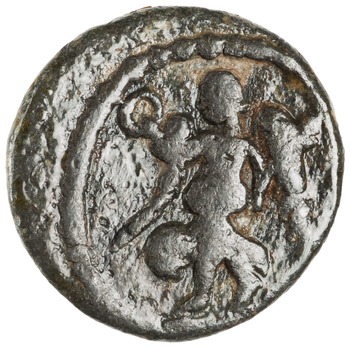 |
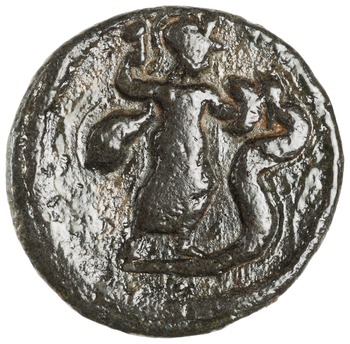 |
These objects shed light on the economic history of Egypt, as well as the self-representation of different groups within the province, similar to the way that the designs of provincial coinage reflect the identities and culture of local cities. That alternative or community currencies existed alongside the denarius system in the Roman Empire reveals how a universal currency used throughout Europe was historically supplemented by other payment systems.
Select Bibliography:
Meshorer, Y. (2010). Coin Hoard from a Third-Century CE Shipwreck off the Carmel Coast, Atiqot 63: 111-135.
Milne, J. G. (1908). The leaden token-coinage of Egypt under the Romans. Numismatic Chronicle 8: 287-310.
Images from Classical Numismatic Group Inc., Electronic Auction 353, lot 369 (www.cngcoins.com), and the American Numismatic Society, 1944.100.79822.
 Clare Rowan
Clare Rowan

 Please wait - comments are loading
Please wait - comments are loading

 Loading…
Loading…

